

A fennec fox, Vulpes zerda, in the Sahara. This is the smallest canid in the world.
And here is a picture of the sunset I took today from my house in Riverside:

January 2, 2020
In analysis we generalize sequences to nets in order to
handle topological spaces that are too big for sequences to get the
job done. A sequence \(x_i\) has indices that are natural numbers.
In a net, the indices can be in any directed set.
A function between metric spaces is continuous iff it maps every convergent sequence to a convergent sequence. This nice result fails for topological spaces. But a function between topological spaces is continuous iff it maps every convergent net to a convergent net!
A metric space is compact iff every sequence has a convergent subsequence. This nice result fails for topological spaces. But a topological space is compact iff every net has a convergent subnet!
But you have to be careful: the concept of 'subnet' is subtle. The definition is here:
This leads to a puzzle that's bothered me for years. There are topological spaces that are compact where not every sequence has a convergent subsequence!
So the puzzle is: find such a space, and a sequence in that space that has no convergent subsequence, but has a convergent subnet!
By general theorems we know such a situation is possible, but I wanted to find an example that doesn't use the axiom of choice. The reason is that I wanted to know if there was an example that we can actually get our hands on.
I asked this question on Math Stackexchange in last year. After 9 months, Robert Furber gave a promising answer:
He also explains why another style of example does require a nonconstructive princple. The natural numbers embeds in its Stone–Čech compactification in such a way that it has no convergent subsequence. The existence of a convergent subnet implies the existence of a nonprincipal ultrafiter! But there are models of Zermelo-Fraenkel set theory where nonprincipal ultrafilters don't exist.
I still don't understand everything Furber wrote, but I'm pleased that finally, after decades of worrying about this problem, I may finally get some satisfaction.
The mill of math grinds slow, but it grinds exceedingly fine.
January 3, 2020
My wife and I just saw a bobcat outside our house!
This is the second time she's seen it. It had tufted ears, just as a
bobcat should. It stared at her, tail twitching. Then it walked away
before we could photograph it.
January 4, 2020

Cute face. Nightmarish claws. It's the world's biggest bat: the Bismarck masked flying fox.
It lives in Papua New Guinea. Not only the females of this species, but also the males can give milk!
And its genome is much more efficient than yours.

About 45% of your DNA consists of transposons: sequences of genes that can copy themselves from one location to another. There are many kinds. Some act as parasites. Some cause diseases. Many become deactivated and lose the ability to hop around.
About 17% of your DNA is made of transposons called LINEs. Each one is about 7000 base pairs long. Most have lost the ability to replicate — but about 100 still can. As they cut and paste themselves from here to there, they can disrupt your genes and cause cancer.

There are different lineages of LINEs. In humans, the only kind that can still replicate on its own is called LINE1. The rest became inactive about 200 million years ago.
LINE1 is found in all mammals...
... except Old World bats, called megabats, like the Bismarck masked flying fox!
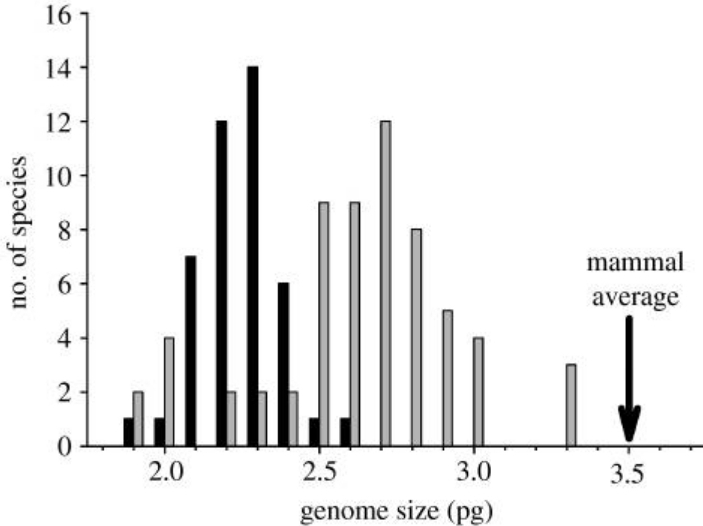
Here's the genome size of various Old World bats (black) and New World bats (gray) compared to the average for mammals. Bats have smaller genomes... and the Old World bats have completely lost their LINE1 junk DNA.
Why? Birds also have smaller genomes, with those that work harder to fly having the smallest. So there's a theory that the need for energy efficiency somehow produces evolutionary pressure to trim down the genome. But nobody really knows.
Here's the paper on the genome sizes of megabats where I got the above figure:
People have done a lot of work on this problem. It's hard. The Solar System is chaotic in a number of ways.
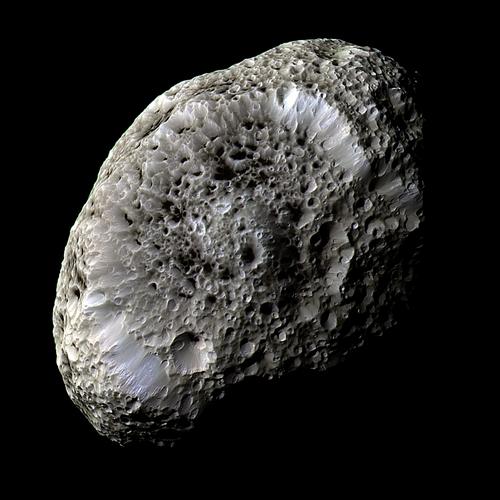
Saturn's moon Hyperion wobbles chaotically thanks to interactions with Titan. It has a Lyapunov time of 30 days. That is, a slight change in its rotation axis gets magnified by a factor of \(e\) after 30 days. You can't really predict what it will do a year from now.
Pluto's moon Nix also rotates chaotically, thanks to its elongated shape and its interactions with Pluto's larger moon Charon. You could spend a day on Nix where the sun rises in the east and sets in the north! Watch the video to see how weird it is.
But what about planets?
Pluto is locked in a 2:3 resonance with Neptune. Apparently this creates chaos: uncertainties in Pluto's position in its orbit grow by a factor of e every 10–20 million years. This makes long-term simulations of the Solar System harder.
In 1989, Jacques Laskar showed that the Earth's orbit is chaotic. An error as small as 15 meters in measuring the position of the Earth today would make it completely impossible to predict where the Earth would be in its orbit 100 million years from now!
The planet Mercury is especially susceptible to Jupiter's influence. Why? Mercury's perihelion, the point where it gets closest to the Sun, precesses at a rate of about 1.5 degrees every 1000 years. Jupiter's perihelion precesses just a little slower.
In some simulations, Jupiter's gravitational tugs accumulate and pull Mercury off course 3-4 billion years from now. Astronomers estimate there's about a 1% probability that it could collide with Venus, the Sun, or Earth — or even be ejected from the Solar System!
In this paper, Laskar and Gastineau simulated 2500 futures for the Solar System, changing the initial position of Mercury by about 1 meter. In 20 cases, Mercury went into a dangerous orbit! In one it passed within 6500 kilometers of Venus. In one it collided with Venus, and in three it collided with the Sun. In one it led to Mars coming within 800 kilometers of Earth 3.3443 billion years from now. This would probably disrupt of Mars, with large fragments hitting Earth.
They were very interested in this last scenario, so they studied 201 slight variants starting at 3.344299 billion years from now, each with slightly different positions of Mars. In five of these Mars was ejected from the Solar System, while the remaining 196 led to collisions: 33 between Mercury and the Sun, 48 between Mars and the Sun, 43 between Mercury and Venus, 1 between Mercury and the Earth, 18 between Venus and the Earth, 23 between Venus and Mars, and 29 between the Earth and Mars.
The most surprising one was a collision between Venus and the Earth that took place in a 5-stage process. First Mercury's orbit became more eccentric through its perihelion resonance with Jupiter, as described. This then increased the eccentricity of the orbits of Venus, the Earth and Mars. When the orbits of the Earth and Mars became very eccentric, it became possible for them to collide. But in the case at hand, Mars didn't hit the Earth. Instead, Mars made the orbit of Venus more eccentric until Venus hit the Earth!
But here's the good news: the work of Laskar and Gastineau — and also another team — shows that nothing dramatic should happen to the planets' orbits for the next billion years. So we can worry about other things.
In the really long term, most of the stars in the Milky Way
will be ejected. Through random encounters, individual stars will
pick up enough speed to reach escape velocity. The whole Galaxy will
slowly 'boil away'. It will dissipate in about \(10^{19}\) years.
January 13, 2020

This chart shows the change in the oceans' heat energy measured in zettajoules. A zettajoule is \(10^{21}\) joules.
It's incredible how much better fossil fuels are at making the Earth retain solar energy than they are at producing useful energy. Let's think about what a zettajoule means!
It's interesting how global warming is the evil twin of solar energy: both
rely on the immense power of the Sun.
January 20, 2020
I see a lot of TV ads from oil and gas companies about how they're
working on renewable energy. They make me feel so good. Women and
men working together for a better future!
Uh-oh.
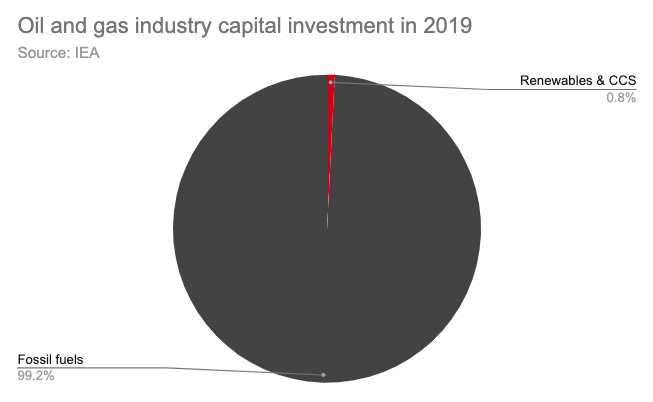
Since 2015 these companies have doubled their spending on renewable energy and carbon capture and storage! That makes me feel so good!
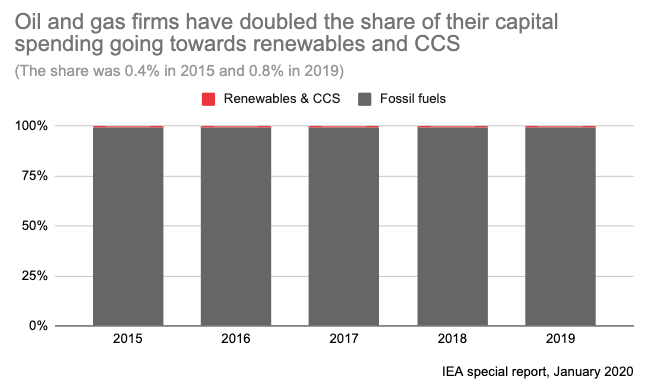
Uh-oh.
Let's face it: oil and gas firms are in business to sell us oil and gas. This might change someday... around when it stops being profitable to them.
We should make that day come soon.
For the full report from the International Energy Agency, go here:
But stars contribute only a tiny fraction of the total entropy in the observable Universe. If it's random information you want, look elsewhere!
First: what's the 'observable Universe', exactly?
The further you look out into the Universe, the further you look back in time. You can't see through the hot gas from 380,000 years after the Big Bang. That 'wall of fire' marks the limits of the observable Universe.
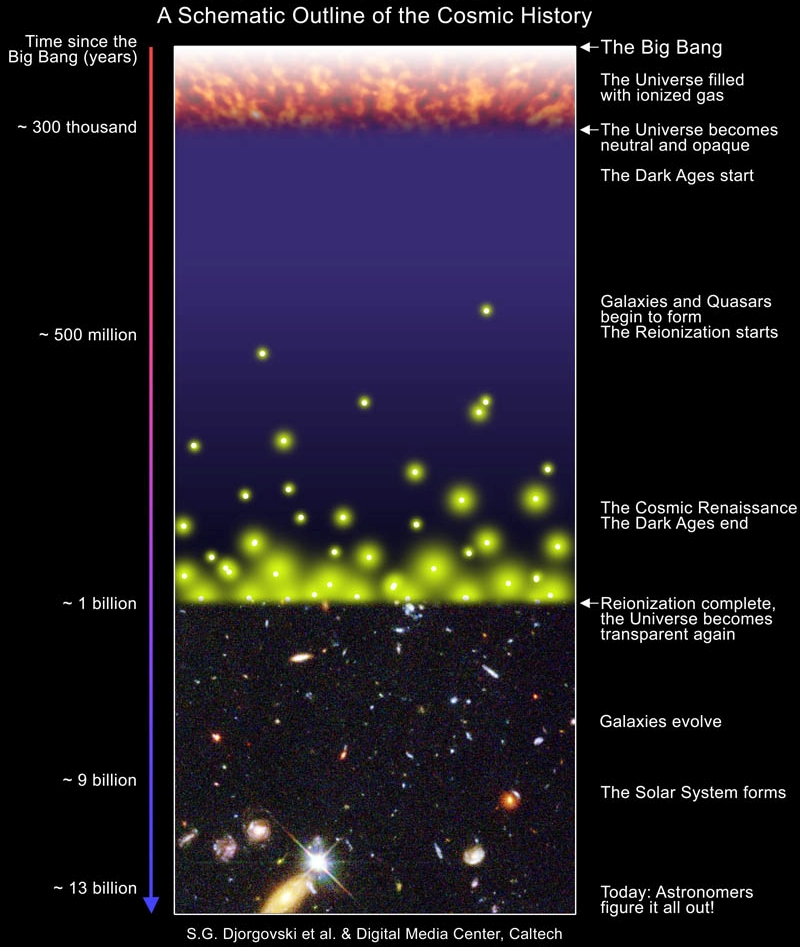
But as the Universe expands, the distant ancient stars and gas we see have moved even farther away, so they're no longer observable. Thus, the so-called 'observable Universe' is really the 'formerly observable Universe'. Its edge is 46.5 billion light years away now! This is true even though the Universe is only 13.8 billion years old. (A standard challenge in understanding general relativity is to figure out how this is possible, given that nothing can move faster than light.)
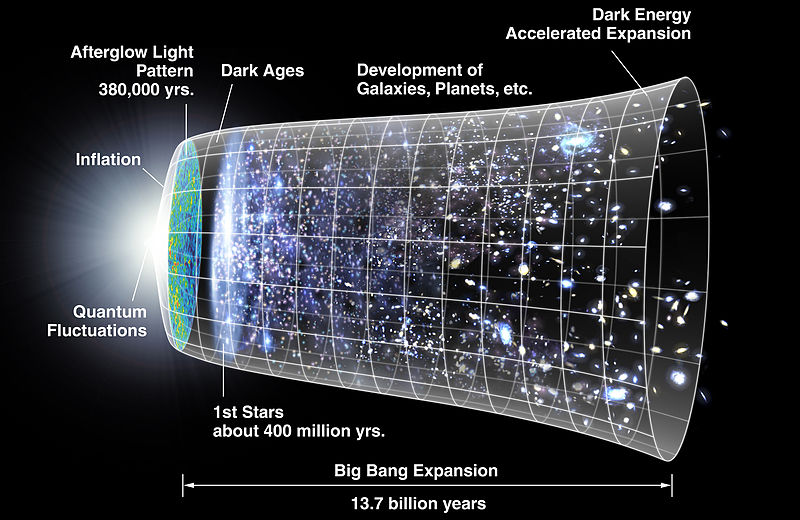
What's the total number of stars in the observable Universe? Estimates go up as telescopes improve. Right now people think there are between 100 and 400 billion stars in the Milky Way. They think there are between 170 billion and 2 trillion galaxies in the Universe.
In 2009, Chas Egan and Charles Lineweaver estimated the total entropy of all the stars in the observable Universe at 1081 bits. You should think of these as qubits: it's the amount of information to describe the quantum state of everything in all these stars.
But the entropy of interstellar and intergalactic gas and dust is about 10 times more the entropy of stars! It's about 1082 bits.
The entropy in all the photons in the Universe is even more! The Universe is full of radiation left over from the Big Bang. The photons in the observable Universe left over from the Big Bang have a total entropy of about 1090 bits. It's called the 'cosmic microwave background radiation'.
The neutrinos from the Big Bang also carry about 1090 bits — a bit less than the photons. The gravitons carry much less, about 1088 bits. That's because they decoupled from other matter and radiation very early, and have been cooling ever since. On the other hand, photons in the cosmic microwave background radiation were formed by annihilating electron-positron pairs until about 10 seconds after the Big Bang. Thus the graviton radiation is expected to be cooler than the microwave background radiation: about 0.6 kelvin as compared to 2.7 kelvin.
Black holes have immensely more entropy than anything listed so far. Egan and Lineweaver estimate the entropy of stellar-mass black holes in the observable Universe at 1098 bits. This is connected to why black holes are so stable: the Second Law says entropy likes to increase.
But the entropy of black holes grows quadratically with mass! So black holes tend to merge and form bigger black holes — ultimately forming the 'supermassive' black holes at the centers of most galaxies. These dominate the entropy of the observable Universe: about 10104 bits.
Hawking predicted that black holes slowly radiate away their mass when they're in a cold enough environment. But the Universe is much too hot for supermassive black holes to be losing mass now. Instead, they very slowly grow by eating the cosmic microwave background, even when they're not eating stars, gas and dust.
So, only in the far future will the Universe cool down enough for large black holes to start slowly decaying via Hawking radiation. Entropy will continue to increase... going mainly into photons and gravitons! This process will take a very long time. Assuming nothing is falling into it and no unknown effects intervene, a solar-mass black hole takes about 1067 years to evaporate due to Hawking radiation — while a really big one, comparable to the mass of a galaxy, should take about 1099 years.
For more details, go here: